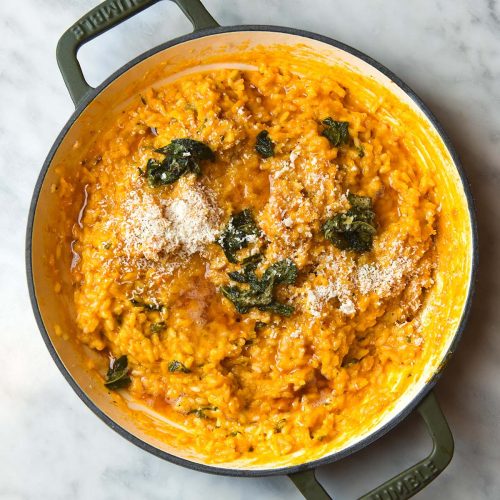
Pumpkin risotto (low FODMAP)
Gluten free, vegetarian option, nut free
Ingredients
For the risotto:
- 500-600 g Japanese or Kent pumpkin roasted and pureed, steamed and pureed or raw and grated (see notes)
- 1-2 tablespoons garlic infused ghee see notes for recipe link
- 20 g fresh sage use divided, woody stems removed and roughly chopped
- 300 g Arborio or Carnaroli rice
- 125-150 ml dry white wine (optional, see body of post)
- 750-1000 ml low FODMAP stock (see notes)
- 100 g freshly and finely grated Pecorino Romano or Parmesan (vegetarian if need be, see notes)
- ground nutmeg to taste
- Plenty of seasoning to taste
- Lemon juice to taste
- Extra grated parmesan to finish
For the brown sage butter (optional):
- 75 g butter browned
- 10 g sage leaves woody stems removed and roughly chopped
Instructions
To make the risotto:
- Place a large pan or pot over a medium heat and add the ghee. Once it is melted and shimmering, add the rice grains and sage. If you don’t intend to finish the risotto with the brown sage butter, add all the sage here. If you do, reserve half for the brown butter.
- Cook for 3-4 minutes or until the rice grains start to become a little bit translucent.
- Once the grains are toasted, add the white wine to the pan. Stir and allow it to be absorbed by the grains. Once absorbed, add a ladle full of warm stock. Stir gently and allow the stock to be absorbed by the grains. Repeat this process until you have used 750ml of stock. From here, assess: is the rice cooked through but firm? Are there any undercooked grains? Does the risotto have a creamy, saucy texture without being sloppy? Add the extra stock, if necessary, to achieve this consistency.
- Once you’re happy with the consistency, take the risotto off the heat. Stir in the warm pumpkin puree. Next, stir in the cheese in batches, adding a splash of extra stock if necessary to achieve a creamy risotto that still holds its shape. Add the nutmeg to your tastes. Add plenty of seasoning (this will depend on how salty your stock is) plus lemon juice to taste.
- Serve with the sage butter drizzled over the top or with a sprinkling of parmesan and pepper. Leftovers keep well in the fridge for a couple of days.
To make the brown sage butter:
- Brown the butter in a frypan over a medium heat. Once nutty and medium brown, add the sage leaves and cook for a minute or two until they start to shrivel. You can cook them until crispy or leave them slightly undercooked for a bit of green.
Notes
- The recipe for garlic infused ghee can be found here.
- You can find my Low FODMAP vegetable stock recipe here.
- Monash have semi-recently (as of November 2024) lowered the threshold for Japanese/Kent pumpkin. It is low FODMAP in 75g serves and up to 161g serves per person. In 162g serves, it contains moderate amounts of fructans. It is still the pumpkin variety that you can eat most of on the low FODMAP diet. Another thing to keep in mind is that you don't need to change anything if you have been eating pumpkin without issue prior to this change.
- If you use 500g pumpkin in this risotto, that equates to 125g pumpkin per serve. This still keeps you within a low FODMAP threshold. If you use 600g pumpkin, that equates to 150g pumpkin per serve. This is still just under a low FODMAP threshold.
- You have three options for adding pumpkin to this risotto. They are:
- 1) Adding raw, grated pumpkin to the risotto after the white rice is added. I found this method a bit unnerving to begin with as it felt it was going to take forever. However, it did work.
- 2) Adding roasted, mashed pumpkin. I chopped the pumpkin into bite sized pieces and roasted it in oil for about 45 minutes. I then mashed the pumpkin on the tray and added it to the pumpkin. Honestly, I didn't taste a huge difference between this and other batches. I'd also recommend keeping in mind that you'll either need to reheat the risotto once the puree is added, or heat the puree prior to adding it.
- 3) Finally, adding pumpkin puree made in the microwave. To do this, I added small cubes of pumpkin to a medium/large heat proof bowl and microwaved it for 5 minutes. I then stirred it, allowed it to steam in the microwave and then microwaved for another 3-5 minutes. A quick mash (or blend) of the pumpkin and you're good to go.
- If you have access to canned pumpkin, I daresay this would also work.
Tried this recipe?Let us know how it was!